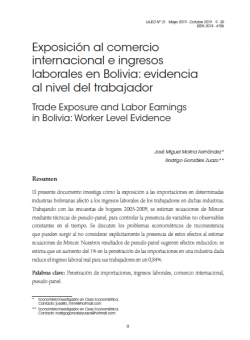Trade Exposure and Labor Earnings in Bolivia: Worker Level Evidence
DOI:
https://doi.org/10.35319/lajed.20193192Keywords:
Import penetration, labor income, international trade, pseudo-panelAbstract
This document investigates how the import exposure in certain Bolivian industries affected workers’ labor income from these industries. Working with the 2005-2009 Household Surveys, Mincer equations are estimated using pseudo-panel techniques to control the presence of constant non-observable time-invariant variables. The econometric problems of inconsistency that can arise when not explicitly considering the presence of these effects when estimating Mincer equations are discussed. Our pseudo-panel results suggest reduced effects: we estimate that a 1% increase in imports penetration in a given industry reduces real labor income for its workers by 0.84%.
Downloads
References
Abadie, A.; Athey, S.; Imbens, G. W. y Wooldridge, J. (2017). When should you adjust standard errors for clustering? (Nº. w24003). National Bureau of Economic Research.
Autor, D. H.; Dorn, D.; Hanson, G. H. y Song, J. (2014). “Trade adjustment: Workerlevel evidence”. The Quarterly Journal of Economics, 129(4), 1799-1860.
Autor, D. H.; Dorn, D. y Hanson, G. H. (2016). “The china shock: Learning from labormarket adjustment to large changes in trade”. Annual Review of Economics, 8, 205-240.
Banco Mundial, World Development Indicators. (2018). "Volumen de importaciones Bolivia".
Barja, G. y Zavaleta, D. (2016). “Disminución de precios de commodities en un ambiente de enfermedad holandesa y bendición/maldición de los recursos naturales”. Revista Latinoamericana de Desarrollo Económico, (25), 7-40.
Benjamin, D. J.; Berger, J. O.; Johannesson, M.; Nosek, B. A.; Wagenmakers, E. J.; Berk, R.; Cesarini, D… (2018). “Redefine statistical significance”. Nature Human Behaviour, 2(1), 6.
Deaton, A. (1985). Panel data from time-series of cross-sections. Econometric Research Program, Princeton University.
Devereux, P. J. (2007a). “Small‐sample bias in synthetic cohort models of labor supply”. Journal of Applied Econometrics, 22(4), 839-848.
---------- (2007b). “Improved errors-in-variables estimators for grouped data”. Journal of Business & Economic Statistics, 25(3), 278-287.
Ebenstein, A.; Harrison, A.; McMillan, M. y Phillips, S. (2014). “Estimating the impact of trade and offshoring on American workers using the current population surveys”. The Review of Economics and Statistics, 96(4), 581-595.
Galiani, S. y Porto, G. G. (2010). “Trends in Tariff Reforms and in the Structure of Wages”. The Review of Economics and Statistics, 92(3), 482-494.
Gonzáles, R. (2016). “External Shocks, Dutch Disease and Informality in Bolivia”. CIESS Econométrica-Universidad Mayor de San Andrés. Working Paper.
Instituto Nacional de Estadística, Estadísticas de Comercio Exterior (2018). “Penetración de las importaciones y remuneraciones reales en Bolivia”. La Paz, Bolivia.
---------- (2005). “Clasificación de actividades económicas de Bolivia”, CAEB-2005. Disponible en: http://anda.ine.gob.bo/ANDA4_2/index.php/catalog/274/download/1076
Lay, J.; Thiele, R. y Wiebelt, M. (2008). “Resource booms, inequality, and poverty: The case of gas in Bolivia”. Review of Income and Wealth, 54(3), 407-437.
Mincer, J. (1974). “Schooling, Experience, and Earnings”. Human Behavior & Social Institutions, Nº 2, National Bureau of Economic Research.
Moffitt, R. (1993). “Identification and Estimation of Dynamic Models with a Time Series of Repeated Cross-Sections”, Journal of Econometrics, (59), 99-123.
Nina, O. y Andersen, L. E. (2004). “Regional integration and poverty: A case study of Bolivia” (Nº 06/2004). Institute for Advanced Development Studies.
Pavcnik, N. (2017). “The impact of trade on inequality in developing countries” (Nº w23878). National Bureau of Economic Research.
Pischke, J. S. y Schwandt, H. (2012). “A cautionary note on using industry affiliation to predict income” (Nº w18384). National Bureau of Economic Research.
Prudencio, J. (2017). “El sistema agroalimentario y su impacto en la alimentación y nutrición”. Disponible en: http://cdn.biodiversidadla.org/content/download/147349/1121408/version/1/ file/El+sistema+agroalimentario+en+Bolivia+y+su+impacto+en+la+alimentaci%C3% B3n+y+nutrici%C3%B3n.odt
Sachs, J. D., y Warner, A. M. (1995). “Natural resource abundance and economic growth” (Nº w5398). National Bureau of Economic Research.
Verbeek, M. y Nijman, T. (1992). “Can cohort data be treated as genuine panel data?”. En: Panel data analysis (9-23). Physica-Verlag HD.
Verbeek, M. (2008). “Pseudo-panels and repeated cross-sections. In the econometrics of panel data” (369-383). Springer, Berlin, Heidelberg.
Wooldridge, J. M. (2010). Econometric analysis of cross section and panel data. MIT Press.






